I started this post in late April and early May, 2022, but never finished pulling together images etc and getting it posted. So here we are, a year and a month later, heading toward another Summer Solstice, the burgeoning green and florescence of the season pushed along by the earlier spring work of Ūsiņš! So enjoy this bit of a look back to Spring. Photos are from 2022 and 2023, from late April through mid-May.
 |
| The beginning of spring growth- Aspens open their catkins full of tiny flowers! |
More recently I was looking for Latvian mentions of a bee goddess- since Lithuanians have Austeja 'patron of flowers, protector of bees and women especially pregnant ones. She is also a fertility goddess. Her name is connected to the Lithuanian word "austyti" which means to continually go back and forth like in weaving (or flying back and forth from the hive)." [both powerful images in ancient societies] excerpt from this page on Baltic belief systems: http://zagarins.net/sveiks/2002/AABS/AVB_doctoral_thesis/8.htm Latvians don't *seem* to have a direct analog to Austeja, though they have one of the 'Little Mothers' (secondary goddesses or aspects of the Great Goddess, each with fairly particular purviews): Ziedu Mate/ Flower Mother, responsible for flowers, and this seems likely to be related. Other Mothers are responsible for forest, shrubs, etc. I can perhaps imagine Flower Mother moving through forest and meadow, flowers springing up in her wake, as Ūsiņš moves through the sky, escorting Sun on her triumphant return, his warm touch greening the leaves and waking bees from winter slumber!
Now, the original post, with lots of amendment:
I recently came across a mention of Jurgis, a Latvian celebration of spring, around April 23. A bit more digging makes me think that this deity and occasion may stem from a conflation of Christian Saint George and more ancient practises associated with the god Ūsiņš. I say 'may', since, even though Latvia was among the last European countries to adopt Christianity, and has retained a cultural practise full of pagan elements, the details of beliefs and practises before the Christian era are not fully known.
 |
| Marsh Marigold/Caltha palustris, one of the first wildflowers |
The Latvians of those times had no texts of their own detailing their religion/culture, so we are left with occasional reports by outsiders, who may have been biased (such as Church officials) or simply not have seen or understood everything. Our only other sources are a large body of ancient folk songs (which have remained unchanged, and often give important hints), and modern practises and superstitions, from which clues might be gleaned and theories formed, but not certainties.
 |
| Balsam Poplar /Populus balsamifera catkins emerging |
While I find the snippets of information interesting, and might have my own opinions at times about the likelihood of various possibilities (for example, often easy to see where the Church has interjected itself), the exact truth of the ancient ways is not that crucial for me. I am learning about the ways of one set of my ancestors to help me develop my own way of relating to and celebrating the seasons and the world around me. My life/world is not exactly theirs- I live in the country, but I am not a farmer; I'm a vegetarian; I live in Canada, not Latvia. So, really, I'm looking for a direction rather than a specific destination.
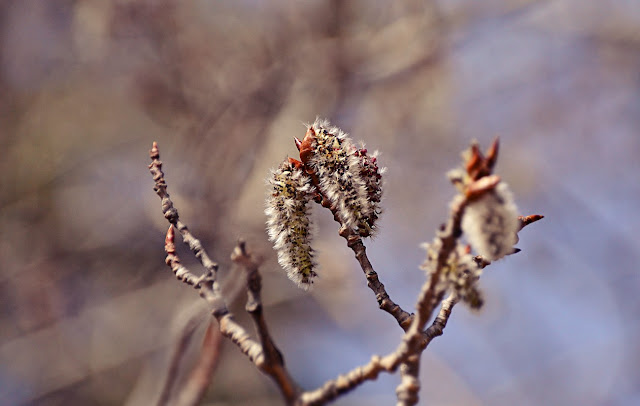 |
| Aspen catkins ready to open |
So, back to Ūsiņš. As I suggested above is common in Latvian mythology, there is considerable debate about the etymology and origins of Ūsiņš, both as a name and as a concept. Ūsiņš is often considered a god of light, of spring, associated with the sun -secondarily, as a son or helper: there is a connection to Indo European divine twins myths, with Ūsiņš being one of the twins, driving a carriage drawn by two white horses which carries the sun across the sky [see my Mārtinš post for the possible other twin]. Further associations are with morning and/or evening stars (very important in early calendrical systems), bringing of spring and the return of leaves and green. He is strongly associated with horses (a possible etymology of the name connects it to Vedic -ancient Indian- horse gods), and Ūsiņš Day has many rituals concerned with caring for animals. He is also associated with bees, though that is debated (perhaps another god with a similar name? nonetheless the associations remain). It has also been suggested that the name comes from a Germanic term for house spirit (domestic spirits have been important in many cultures, see my upcoming-eventual? post on Pukis), or from ancient Slavic deities. No doubt some of the confusion stems from the fact that gods do not remain static in a culture, but are adapted or have different aspects recognised and emphasised as the culture changes internally or in response to external inputs.
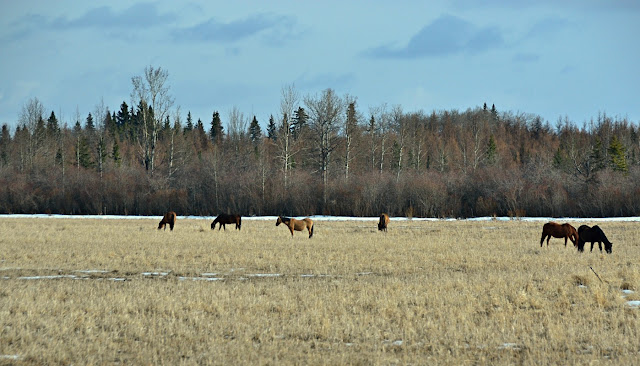 |
| Horses in early spring pasture awaiting the arrival of Green! |
 |
| Green blush of spring begins in the wetlands |
As with any spiritual or religious activity, these dates serve as an excuse for a social day and as markers for the timing of seasonal tasks (important aspects historically and in primarily agrarian cultures). But they can also give occasion to bring our thoughts and mood (therefor attitude, being, body, health) into alignment with aspirational beliefs, with the rhythms and physicality of the seasons, with the world around us! On a very simple level, for example, paying attention to this natural unfolding of the seasons has left me much more at peace with the rhythm of the year- I know winter will pass, I know spring will unfold, I know all sorts of weather have their time. That's just science, really, and there is a beauty and comfort in being attentive to the patterns, but adding details of historical cultural practise brings in elements of personality, fun and interest, and room for thought provoking symbolism along the way!
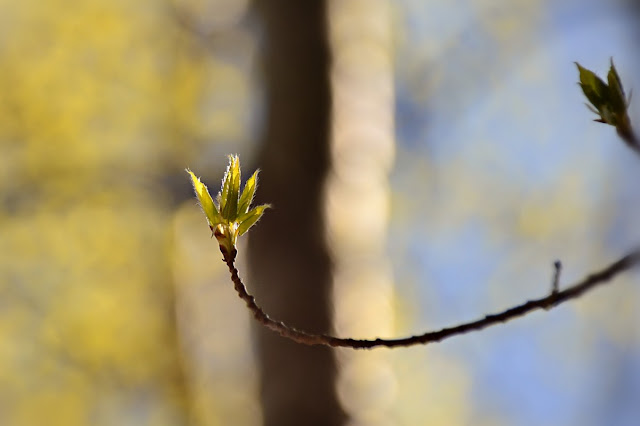 |
| Burgeoning green-gold emerging leaves echo the sun |
Now again back to our original focus- Ūsiņš! I don't raise horses, that's why the photo above was snapped from the car! Neither do I raise bees, *but* I am keenly aware of the native bees in my gardens and surrounding wild areas, as well as neighbours' honeybees that may visit. I tend to view my greatest success as a gardener in the abundance and variety of pollinators I see (a myriad of flower flies, wasps, butterflies, moths, beetles, insects in general), including more types of bees than I knew existed, a few years ago! So, I'll honour Ūsiņš as guardian of the bees- who have mostly just started to appear for the year. Also, of course, his role in bringing back the sun and green to the land is welcome, and again, the dates work fairly well here, as the ever lengthening days and melting of snow bring the gradual return of plant growth here. In the original division of seasons, after Ūsiņš Day, we should be into summer, the Time of Flowers. Really, here it is just beginning, but things move fast from this point on.
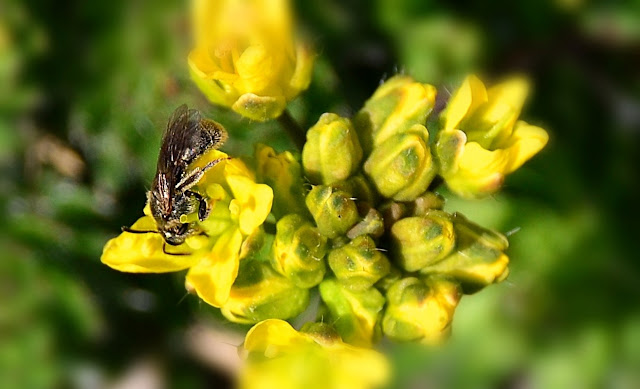 |
| Tiny early native bee on Draba flowers |
 |
| Tiny red Nomada bee in the rock garden |
 |
| Tiny bee with Snowdrop/Galanthus |
I admit a bias toward the ancient (or Old European, as the pre-Indo-European cultures are sometimes referred to) goddesses of earth/water/below the earth more so than the later sky gods (apart from Sun/Saulė! and Moon/Mēness, but their veneration must also stem from the earliest times). I can, though, appreciate a god that helps bring the sun, that brings green to leaves and grass, ushering in the growing season. That seems to echo a reverence that likely pre-dates the Indo-European gods, whether one of the new sky gods was combined with a pre-existing deity, or there are more ancient traits of this Indo-European god that were lost or downplayed in other versions.
 |
| Spring Aspen leaves with Dandelion |
So, in the end , for Ūsiņš Day (Jurgis was April 23, Ūsiņi May 6, maybe 9? again some vagueness, which leaves me free to celebrate when/as I have time ) I've chosen some images that represent the coming season of growth and warmth, the progress of Saulė/Sun on her yearly journey, escorted by a dashing young god of green vitality and buzzing energy!
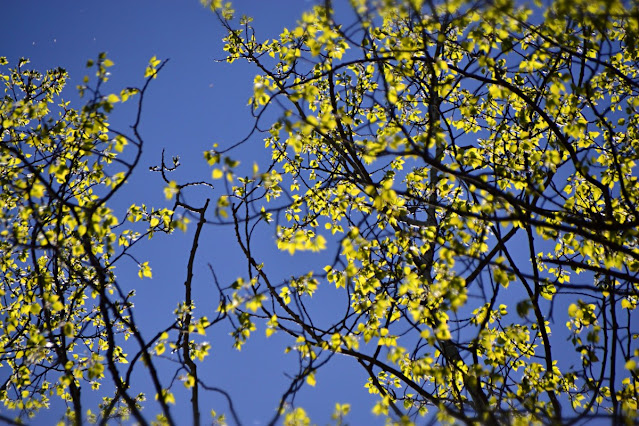 |
| Sun green new Aspen leaves |
 |
| Sun green new Aspen leaves |
I started writing this as we in the Northern Hemisphere move from earliest spring into the transition to summer, we are now in the thick of the green! You who read this could be in nearly any season, so I will simply wish you a season of growth- in spirit and heart, as well as garden if it is the right time of year for you! May you enjoy the blessings of the fruitful seasons to come; if you are in a place where Saulė /Sun is punishing in summer, may you enjoy the gentler time before, and may the summer be a mild one! As ever, our friends on the other half of the planet are at the opposite end of the year-- may your autumn be beautiful, your winter as wet as it needs to be. But above all, in any and all seasons, may you find a connection with our Mother, Earth, the rhythms of Sun and Moon, wet and dry, hot and cold. May it give you peace and purpose!
Cohan, June 11, 2023, Condor, Alberta, Canada
edit: November 09, 2023- I'm trying to get better at spelling the Latvian names correctly, including proper markings on letters etc-I've edited some in this post, no doubt others have been missed! Future posts should be better. For the casual reader, don't worry about it! Say the names in your head as you wish!
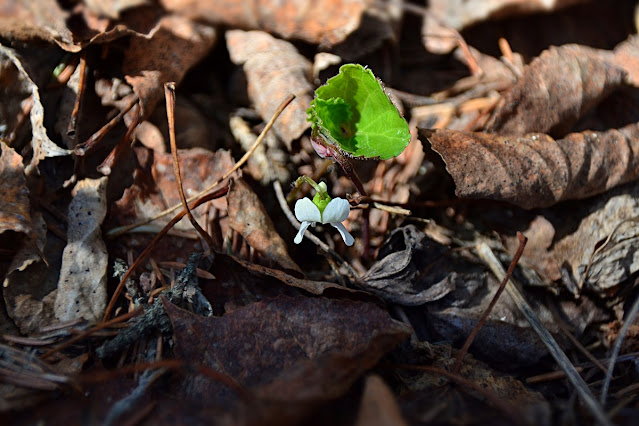 |
| Viola renifolia / Early White Violet |
 |
| Ribes triste/ Northern Red Currant with tiny visiting fly |
Comments on the ease of reading on this platform are welcome. I'm also starting to experiment with Wordpress. You can find me on
If you are able and would like to support me, I have a Ko-fi page; support helps me keep working-more research, more writing, more art!
(see this post for musings on support sites: https://cohanmagazine.blogspot.com/2021/01/fiction-feedback-and-finances.html ).
As usual, if you love an image, it could be loaded to any of the print on demand sites as cards, prints, mugs, clothing etc. Haven't played with any of those for a while, hope to get back at them soon.
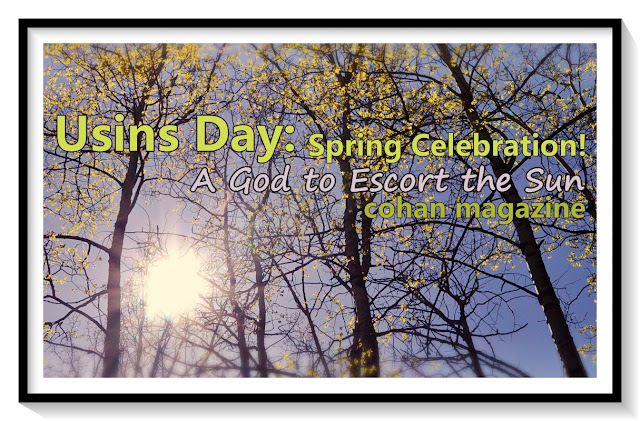

Comments
Post a Comment